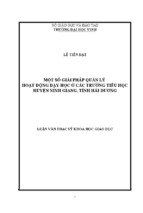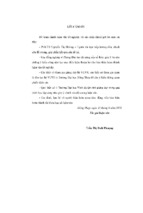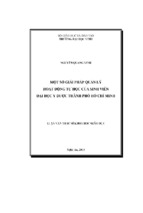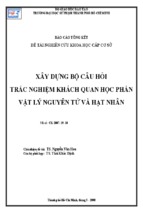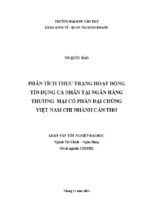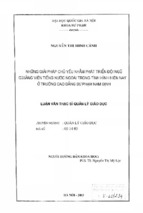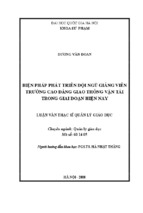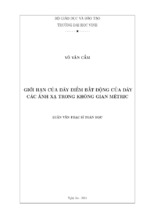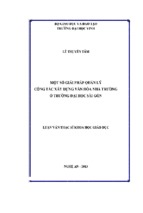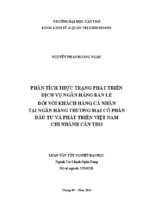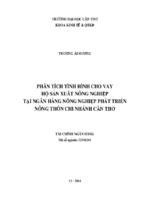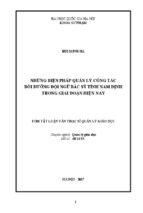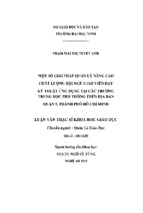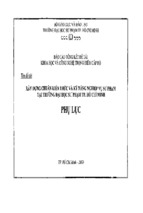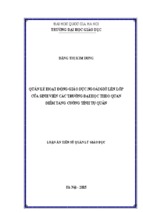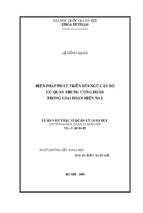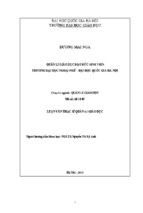Tài liu lun vn s phm , giáo dc1 of 63.
HANOI PEDAGOGICAL UNIVERSITY 2
FACULTY OF FOREIGN LANGUAGES
= = == = =
CAO THI VAN ANH
A STUDY ON FACTORS AFFECTING FIRST-YEAR
ENGLISH MAJOR STUDENTS’ MOTIVATION IN ENGLISH
SPEAKING CLASSES AT HANOI PEDAGOGICAL UNIVERSITY 2
(SUBMITTED IN PARTIAL FULFILLMENT OF THE REQUIREMENTS OF
THE DEGREE OF BACHELOR OF PEDAGOGY IN ENGLISH)
Field: English Language Teaching
Hanoi, May 2019
Footer Page 1 of 63.
Tài liu lun vn s phm , giáo dc2 of 63.
HANOI PEDAGOGICAL UNIVERSITY 2
FACULTY OF FOREIGN LANGUAGES
= = == = =
CAO THI VAN ANH
A CASE STUDY ON FACTORS AFFECTING FIRST-YEAR
ENGLISH MAJOR STUDENTS’ MOTIVATION IN ENGLISH
SPEAKING CLASSES AT HANOI PEDAGOGICAL UNIVERSITY 2
(SUBMITTED IN PARTIAL FULFILLMENT OF THE REQUIREMENTS OF
THE DEGREE OF BACHELOR OF PEDAGOGY IN ENGLISH)
Field: English Language Teaching
SUPERVISORS:
Nguyen Thi Minh Phuong, M.A
Dr. William H. Salazar, Ed.D
Hanoi, May 2019
Footer Page 2 of 63.
Tài liu lun vn s phm , giáo dc3 of 63.
STATEMENT OF THE AUTHORSHIP
Title: A study on factors affecting first-year English major students’
motivation in English speaking classes at Hanoi Pedagogical University 2
I hereby certify that this thesis is entirely my own work under strict guidance
from my supervisors and no part of this report has been copied or reproduced by me
from other person‟ work without the proper acknowledgements. I have also
provided fully documented references to the work of other researchers.
Date submitted: May 10th 2019
Student
Supervisor 1
Supervisor 2
Cao Thi Van Anh
Nguyen Thi Minh Phuong, M.A
Dr. William H. Salazar, Ed.D
i
Footer Page 3 of 63.
Tài liu lun vn s phm , giáo dc4 of 63.
ACKNOWLEDGMENT
In the completion of this thesis, first of all, I would like to express my
gratitude to my supervisors, Ms Nguyen Thi Minh Phuong, M.A who taught me
how to organize my thesis and Dr. William H. Salazar, Ed.D who helped me
organize my ideas and how to edit my paper for their experience, guidance,
stimulating suggestions and encouragement throughout my research.
Additionally, I would like to convey my deepest thanks to the lecturers in the
Faculty of Foreign Languages for their advice and assistance in introducing me
many reference materials related to this research project.
I am especially indebted to 50 first-year English major students at Hanoi
Pedagogical University 2 for their participation into my study.
Last but not least, I owe my special thanks to my loving parents, my younger
brother and my dear friends who offered me their love, care, support and
encouragement so that I could accomplish my study.
Hanoi, May 2019
ii
Footer Page 4 of 63.
Tài liu lun vn s phm , giáo dc5 of 63.
ABSTRACT
Motivation is one of the most vital factors determining the success or failure
of students‟ foreign language learning. Without motivation, nothing can be
accomplished. But in spite of that, in reality many students in general and some
students at Hanoi Pedagogical University 2 in particular, do not have enough
motivation to practise speaking English smoothly. While speaking is considered one
of the most important skills when compared with other skills; it is the most essential
skills in our daily lives and is the most effective mean of communication. Therefore,
this study was implemented to investigate the factors affecting first-year English
major students‟ motivation in English speaking classes at Hanoi Pedagogical
University 2. The participants were 50 first-year English major students and three
lecturers of English. Survey questionnaire, interviews and classroom observations
were used as the major data collection instruments. The data were computed and
analyzed. The major findings demonstrated that there were four main groups of
factors that affect students‟ motivation in English speaking classes in order of
importance: (1) Student – related factors (mean = 3.59); (2) Lecturer – related
factors (mean = 3.4); (3) Classroom – related factors (mean = 3.3) and; (4) Course
book – related factors (mean= 2.72). Mean scores of 3.5-5.0 on the 5-point Likert
scale were defined as highly motivated; mean scores of 2.5-3.4 were defined as
moderately motivated; and mean scores defined as lowly motivated were 1.0-2.4.
Based on the findings of this study, implications and suggestions to increase
students‟ positive motivation at Hanoi Pedagogical University 2 were made: 1)
Intrinsic and Extrinsic motivation are very important to increase students‟ speaking
skill level. 2) Lecturers should design interesting activities that are relevant to
students. 3) Lecturers should create a positive classroom environment and show
their enthusiasm in their teaching.
Key words: student motivation, factors affecting motivation, English speaking
classes, first-year English major students, L2 motivation
iii
Footer Page 5 of 63.
Tài liu lun vn s phm , giáo dc6 of 63.
LIST OF ABBREVIATIONS
HPU2
Hanoi Pedagogical University 2
FFL
Faculty of Foreign Languages
L2
Second language
iv
Footer Page 6 of 63.
Tài liu lun vn s phm , giáo dc7 of 63.
LIST OF TABLES AND CHARTS
LIST OF TABLES
Table 1: Demographics of the participants ..............................................................22
Table 2: Student – related factors .............................................................................23
Table 3: Lecturer – related factors ...........................................................................26
Table 4 : Classroom – related factors ......................................................................29
Table 5 : Course book – related factors ...................................................................31
Table 6: The comparison among four factors ...........................................................33
LIST OF CHARTS
Chart 1: Student – related factors .............................................................................23
Chart 2: Lecturer – related factors ...........................................................................26
Chart 3: Classroom – related factors .......................................................................29
Chart 4 : Course book – related factors ...................................................................31
Chart 5 : The comparison among four factors .........................................................33
v
Footer Page 7 of 63.
Tài liu lun vn s phm , giáo dc8 of 63.
TABLE OF CONTENTS
PART A. INTRODUCTION ...................................................................................... 1
1. RATIONALE .......................................................................................................... 1
2. AIMS OF THE STUDY.......................................................................................... 2
3. RESEARCH QUESTIONS ..................................................................................... 3
4. METHOD OF THE STUDY .................................................................................. 3
5. SCOPE OF THE STUDY ....................................................................................... 3
6. SIGNIFICANCE OF THE STUDY ........................................................................ 3
7. DESIGN OF THE STUDY ..................................................................................... 4
PART B. DEVELOPMENT ....................................................................................... 5
CHAPTER ONE: LITERATURE REVIEW .............................................................. 5
1.1. Motivation in Second/ Foreign Language Learning ............................................ 5
1.1.1. Definition of Motivation ................................................................................... 5
1.1.2. Definition of Motivation in L2 Acquisition ...................................................... 6
1.1.3. Motivation in Practising English Speaking Skills............................................ 6
1.1.4. Types of Motivation .......................................................................................... 7
1.1.4.1. Intrinsic and Extrinsic Motivation ................................................................. 7
1.1.4.2. Integrative and Instrumental Motivation........................................................ 8
1.2. Motivation in L2 Speaking Classroom ................................................................ 9
1.2.1. Related Issues of Speaking Skills ..................................................................... 9
1.2.1.1. Some Definitions of Speaking Skills ............................................................. 9
1.2.1.2. Types of Classroom Speaking Performance ................................................ 10
3.2. Motivation in Speaking Classroom .................................................................... 10
3.2.1. Factors Demotivate Students to Speak in Classes .......................................... 10
3.2.2. Some Conditions for Effective Motivation in Speaking Classroom ............... 11
1.3. Factors Affecting Motivation in L2 Learning .................................................... 12
1.3.1. Dornyei‟s Extended Motivational Framework ............................................... 12
1.3.2. Williams and Burden‟s Framework of the L2 Motivation .............................. 12
1.3.3. Factors Affecting Students‟ Motivation in Learning L2 ................................. 13
1.3.3.1. Student – related Factors .............................................................................. 13
vi
Footer Page 8 of 63.
Tài liu lun vn s phm , giáo dc9 of 63.
1.3.3.2. Lecturer – related Factors............................................................................. 14
1.3.3.3. Classroom – related Factors ......................................................................... 15
1.3.3.4. Course book – related Factors ...................................................................... 15
1.3.4. Previous Studies on Factors Affecting Students‟ Motivation in L2
Speaking Class .......................................................................................................... 15
CHAPTER TWO: RESEARCH METHODOLOGY ............................................... 17
2.1. Description and Context of the Study ................................................................ 17
Participants ................................................................................................................ 17
2.2. Data Collection Instruments:.............................................................................. 18
2.2.1. Survey Questionnaire for Students (Appendix A) .......................................... 18
2.2.2. Interview for Lecturers and Students (Appendix B) ....................................... 19
2.2.3. Classroom Observation (Appendix C) ............................................................ 19
2.4. Data Analysis ..................................................................................................... 20
CHAPTER THREE: RESULTS AND DISCUSSION ............................................. 22
3.1. Results ................................................................................................................ 22
3.1.1. Results of Survey Questionnaire, Interviews and Classroom
Observations about Factors Affecting the First-year English Major Students‟
Motivation in English Speaking Classes ................................................................... 22
3.1.1.1. Demographics of the Students taking part in the Survey ............................. 22
3.1.1.2. Student – related Factors .............................................................................. 22
3.1.3. Lecturer – related factors ................................................................................ 25
3.1.4. Classroom – related Factors ............................................................................ 28
3.1.5. Course book – related Factors ......................................................................... 30
3.1.6. The Comparison among Four Factors Affecting Sudents‟ Motivation in
English Speaking Classes .......................................................................................... 32
3.2. Discussion of Findings on Factors Affecting Students‟ Motivation in
English Speaking Classes .......................................................................................... 34
3.2.1. Student – related Factors ................................................................................. 34
3.2.2. Lecturer – related Factors................................................................................ 35
3.2.3. Classroom – related Factors ............................................................................ 36
3.2.4. Course book – related Factors ......................................................................... 36
CONCLUSION ......................................................................................................... 38
vii
Footer Page 9 of 63.
Tài liu lun vn s phm , giáo dc10 of 63.
1. Summary of the Study ........................................................................................... 38
2. Pedagogical Implications ...................................................................................... 38
3. Limitations of the Study ........................................................................................ 40
4. Suggestions for Future Research ........................................................................... 40
REFERENCES .......................................................................................................... 42
APPENDICES........................................................................................................... 46
viii
Footer Page 10 of 63.
Tài liu lun vn s phm , giáo dc11 of 63.
PART A
INTRODUCTION
This section discusses the reasons for carrying out this study, defines the
aims of the study, research questions, scope of the study and methods of the study.
The significance of the study and the outline of the study are also presented.
1. RATIONALE
With the globalization trend, English has emerged as a crucial
communication language in Vietnam. Many English-speaking foreigners from many
countries have begun coming and investing in Vietnam. This has prompted
Vietnamese citizens to learn English to communicate efficiently with their foreign
counterparts. Moreover, the importance of English was immediately recognized by
the Vietnamese government and English is taught as a compulsory subject in
primary, secondary, high schools and universities in Vietnam.
English in the modern world plays a very important role in exchanging and
seeking information, for each individual, it has different levels of need. However,
Vietnamese students are facing many opportunities and challenges in the
transitional period of a “developing” globalized Vietnamese society and the
cultivation of English sources is the key to gain educational and career success.
Fluent communication in English will give English learners an advantage in the
competitive job market.
In Vietnam, English language teaching at secondary and high schools
focuses mainly on grammar, vocabulary and sentence structure. In a teaching
format, conversational English is not usually taught because learning and teaching
English is mainly based on testing, with the exams focusing mainly on grammar.
Primary through high school curriculums in many schools focus on preparing
students to pass their entrance exam to the next level, therefore, teachers only teach
the necessary things which help their students to pass the exams; and unfortunately
do not focus on developing students‟ speaking skills. This is one of the reason why
students lose motivation because English is just a subject at school; and is not part
of their lives. Many students fail to understand the significance of the ability to
speak English fluently. At the university level, students who are motivated to
enhance their English speaking skills can pursue a Bachelor of Arts in English or a
Bachelor of English. After graduating, they can be lecturers of English or
1
Footer Page 11 of 63.
Tài liu lun vn s phm , giáo dc12 of 63.
interpreters in English according to their proficiency. Students in these programs
usually study for four years and the subjects they learn include linguistic and
teaching methods. In fact, teaching methods or classroom environment do not create
opportunities for students to satisfy their communication needs. Therefore,
Vietnamese students have difficulties in communicating in English fluently and
effectively because they do not get the practice they need in English except for a
number of special venues and events such as multinational corporations and
presentation activities. In fact, rarely do we see Vietnamese speaking English unless
it is absolutely necessary. That is the reason why many Vietnamese students are still
deficient in English speaking although they have been studying English since
primary school.
Motivation is an element that plays an important role in inspiring learners to
become proficient in English, esspecially English language learners. It is widely
accepted that the more motivated students are, the more successful they would be at
learning a second/foreign language. It is also undeniable that speaking (any
language) is one of the most essential everyday skills a person needs to function in
society. Therefore, when students have strong motivation to speak English with
accuracy and fluency, they will easily achieve their goals in life.
For the reasons mentioned above, I find that it is really necessary to conduct
a study on factors affecting first-year English major students' motivation in
English speaking classes at Hanoi Pedagogical University 2.
2. AIMS OF THE STUDY
This study aims at investigating the factors affecting first-year English major
students' motivation in English speaking classes at HPU2. This project is carried out
with the following purposes:
- Identifying and analyzing the influence of four factors (student – related
factors, lecturer – related factors, classroom – related factors and course book –
related factors) affecting first-year English major students' motivation in English
speaking classes
- Comparing the levels of effect on these motivational factors
2
Footer Page 12 of 63.
Tài liu lun vn s phm , giáo dc13 of 63.
3. RESEARCH QUESTIONS
To achieve the research objectives mentioned above, the following research
questions were designed for exploration:
1. How do these four factors (student – related factors, lecturer – related
factors, classroom – related factors and course book – related factors) affect firstyear English major students in English speaking classes at HPU2?
2. What is the comparison among these four factors?
4. METHOD OF THE STUDY
To achieve the objectives of the study, the following research instruments
were used to collect data:
1. Student survey questionnaire
2. Interview (lecturers and students)
3. Classroom observation
Survey questionnaires were used to collect demographic information from
students. In addition, to make the data collected more reliable and authentic, two
following instruments were also applied: interviews with lecturers and students and
classroom observations to find out students and lecturers‟ ideas about the four
factors affecting first-year English major students‟ motivation in English speaking
classes.
5. SCOPE OF THE STUDY
It is clear that motivation has a great impacts on students‟ English language
proficiency. However, this study just makes a limited insight in only a narrow area
– students‟ speaking skills; and focuses on this study of the 50 first-year English
major students at HPU2 instead of all K44 English major students.
6. SIGNIFICANCE OF THE STUDY
This research aims to provide pedagogical implications for educational
administrators, lecturers and students. For more details, the research results can help
those who do quality management teaching at HPU2 have an overall view and wish
to improve the quality of teaching students through the factors in this research
project. Therefore, it is the basis for conducting this research in order for
administrators and lecturers to develop a step-by-step improvement plan to improve
3
Footer Page 13 of 63.
Tài liu lun vn s phm , giáo dc14 of 63.
the quality of teaching and learning for their school. This research will also help
students to know how the factors influence their speaking‟s motivation and they
will have the capacity to train themselves to enhance their motivation in learning
especially their English speaking skills.
7. DESIGN OF THE STUDY
Apart from the acknowledgment, the references, the appendices, the basic
design of this study consists of the following three parts: Introduction, Development
and Conclusion.
PART A: INTRODUCTION
The introduction discusses the rationale for carrying out this study, defines the
aims of the study, research questions, scope of the study and methods of the study as
well as the significance of the study. The outline of the study is also presented.
PART B: DEVELOPMENT
Chapter one: Literature Review
The literature review provides an overview of theoretical background of
speaking, motivation, motivation in practising English speaking skills, especially
factors affecting students‟ motivation in practising English speaking skills.
Moreover, some studies about factors affecting students‟ motivation are also
presented in the overview of the literature review.
Chapter two: Methodology
This section discusses the methodology for this study and the procedure for
carrying out the study such as the selection of participants, the data collection
instruments, the data procedures and the data analysis.
Chapter three: Results and Discussion
This chapter reports the results of the data analysis and provides discussion
of the data analysis.
PART C: CONCLUSION
This part deals with the conclusion of the whole study and proposes some
implication based on the findings of the study. This is followed by a discussion of
the limitations of the study as well as some suggestions for future stud
4
Footer Page 14 of 63.
Tài liu lun vn s phm , giáo dc15 of 63.
PART B
DEVELOPMENT
CHAPTER ONE: LITERATURE REVIEW
This chapter provides an overview of motivation in L2 learning, motivation
in L2 speaking class especially factors affecting students‟ motivation in L2 speaking
class. Moreover, some studies about factors affecting students‟ motivation in
speaking classes are also presented.
1.1. Motivation in Second/ Foreign Language Learning
1.1.1. Definition of Motivation
Motivation is defined in many different ways by many researchers.
Motivation is a concept used popularly in not only education but also in other
research fields. Motivation, in an educational setting, is what promotes us to
perform to learn English, to figure out how to express ourselves in English, or to
teach it (McDonough & Steven 2007). This fundamental explanation reveals four
components: the reasons why we need or want to learn, the desire we want to learn,
the type of individual we are, the English assignment and our estimation of what it
expects from us (McDonough & Steven, 2007).
Motivation, according to lecturers and researchers, influences the rate and
achievement of L2 learning. Additionally, motivation gives the essential impulse to
begin learning L2 and later the main force to keep up the long, tedious and
challenging learning process. In fact, the various components related to L2
acquisition assume motivation to some degree. Without motivation, even adults
with the most specialised skills cannot accomplish their long-term goals, nor are
able to develop educational programs and design excellent instructional lesson plans
to ensure students‟ English proficiency (McDonough & Steven 2007).
However, high motivation can compensate for critical deficiency both in
one's language competence and learning conditions. As indicated by Masgoret and
Gardner (2003), a motivated student extends attempt, assumes responsibility, has
specific goals and desire, appreciate the procedure of learning. Oxford and Shearin
(1996) claimed that motivation is a basic, indispensable part for students who are
completely associated with the learning process.
5
Footer Page 15 of 63.
Tài liu lun vn s phm , giáo dc16 of 63.
1.1.2. Definition of Motivation in L2 Acquisition
Motivation is considered as one of the most important emotional variable in
learning a second language. In reality, many researchers have written motivational
theories that have a great connection with the language learning process. Similarly,
various efforts have been made to determine the motivation for L2 acquisition.
However, each theorist defines motivation in a different way.
Gardner (1985) was a standout amongst the pioneering researchers laying the
groundwork for investigating motivation. For an exploration known as “The role of
attitudes and motivation” he alluded motivation as the mixture of attempt plus
desire to attain the objective of learning the language plus ideal attitudes towards
learning the language. Specially, motivation, according to his view comprises of the
following elements: a goal, a desire to accomplish that goal and the techniques to
achieve the goal.
In Dornyei and Otto study (1998) perspective motivation is characterized as
the process by which a specific amount of force stimulates action and patience, as
long as there is no other powers debilitating it until the arranged objectives are
obtained. In other words, motivation can be considered as a force that a person
starts to act on and continues until they reach the goal.
Ellis (1994), in a general review from his research on motivation, argued that
motivation influences the degree to which language students continue to learn, the
type of behavior they perform and their real accomplishment.
1.1.3. Motivation in Practising English Speaking Skills
Motivation is considered as a key factor influencing the achievement or
failure of language learning. It is as a mental feature which enables individuals to
accomplish a goal. The meaning of motivation has been defined differently by
various reseachers. For instance, Gardner (1985) characterized motivation as the
degree one endeavors to secure the language on account of the desire to do so and
the fulfillment the learners get from it. Dornyei (1994) clarified motivation as an
element of a person's ideas that encodes the information into conviction, and after
that drives to the action.
Another definition was given by Harmer (2001), "Motivation is some kind of
internal drive which pushes someone to do things in order to achieve something".
Obviously, when we have our own goals which are extremely vital to us, we will
6
Footer Page 16 of 63.
Tài liu lun vn s phm , giáo dc17 of 63.
attempt to pursue them. This activity is driven by motivation. In other words,
motivation is the entire vitality of a person to set a goal for an occupation or task
and work to achieve it. Discussing the function of motivation, (Mayer, 2003, p. 459,
cited in Liu, 2010) stated "When students are motivated to learn, they try harder to
understand the materials and thereby learn more deeply, resulting in better ability to
transfer what they have learned to new situations". In some situation, when students
are exceptionally motivated and energetic to develop their speaking ability, they can
achieve their goals.
1.1.4. Types of Motivation
Motivation has been classified in many different ways by different
researchers. Hence, the problem of distinguishing the types of motivation is still
controversial. However, in many studies about motivation, the following two types
of classification have received the most attention.
1.1.4.1. Intrinsic and Extrinsic Motivation
Intrinsic motivation, in general, refers to the reality of completing a task for
itself, the joy, the satisfaction and the fulfillment one obtained from doing the task
(Deci and Ryan, 1985). Intrinsic motivation is controlled by individuals having
individual enthusiasm for accomplishing something and reaching their goals.
Individuals are intrinsically motivated not because the rewards they achieve, but for
the joy of doing an action and activity or task. Some researchers noticed that
students with intrinsic motivation and take part in his/her learning for the wellbeing, and for the self-satisfaction they get. Moreover, the feeling of selfdetermintion and competence are two significant factors enhancing them to pursue
their goals.
Different from intrinsic motivation, extrinsic motivation is performing an
action as obligation and not for the well-being of the individual. (Deci & Ryan,
1985). Schulz (1991) said that the notion of extrinsic motivation referred to the
degree to which the learning condition (the instructor, materials, educational
programs, learning tasks, etc.) contributes or enhances intrinsic motivation of the
students to improving English language skills. Extrinsic motivation, otherwise,
derives from an expectation of rewards such as prizes, praise, assessment or fear for
punishment. An extrinsically motivated students does the action with the goal to
accquire some reward or keep away from some external punishment of the activity
7
Footer Page 17 of 63.
Tài liu lun vn s phm , giáo dc18 of 63.
itself, and this sort of motivation reveals learning circumstances where the
explanation behind completing an undertaking tasks is an option that is other than
an enthusiasm for the assignment itself. Furthermore, undertaking the task might be
something the individual feels compelled to do as opposed to really want to do.
In summary, it turns out to be evident that intrinsic motivation delivers more
potential advantages than the extrinsic motivation. Intrinsically motivated students
have tendency to have more energy and think more deeply than extrinsically
motivated ones.
1.1.4.2. Integrative and Instrumental Motivation
Integrative and Instrumental Motivation are two types of motivation which
were firstly mentioned in Gardner‟s studies (Gardner, 1985; Gardner & Lambert,
1972) and then promoted by other researchers.
Integrative motivation was defined as the learner's orientation on the subject
of the goal of learning a second/foreign language (Crookes & Schmidt, 1991). It is
understood that learner's positive attitudes and the desire to identify with and
integrate into the target language community. Finegan (1999) further showed the
role of integrative motivation as the successful acquisition of a series of native
registration and pronunciation. It is clear that integrative motivation is an important
element to support and enhance the students‟ language proficiency.
In constrast to integrative motivation, instrumental motivation is the basis for
achieving economic or social prizes through L2 accomplishment. Gardner and
Lambert (1972) in their research about motivation mentioned the instrumental
motivation for achieving the vital use of level L2 proficiency. Instrumental
motivation alludes all the students' wish to take on the language to finish a nonpersonal purposes such as to get high marks in exams or to get a good job with high
salary. Besides, instrumental motivation, as stated by Lambert (cited on Ellis,
1997), is something which related to the useful value and favorable circumstances
from taking up a new language.
It is undeniable that both integrative and instrumental motivations are crucial
components to success. However, integrative motivation has been discovered to
support long-term achievement in learning a second language (Taylor, Meynard and
Rheault 1977; Ellis 1997; Crookes et al, 1991). Gardner (1985) accentuated the
vitality of integrative motivation in second language acquisition more than
8
Footer Page 18 of 63.
Tài liu lun vn s phm , giáo dc19 of 63.
instrumental motivation in his studies. He clarified that if students were
instrumentally motivated, they might lose motivation to continue learning when
their goals have been achieved.
According to Brown‟s research (2000), both integrative and instrumental
motivations are not essentially commonly unique. Students feel difficult to choose a
kind of motivation in learning a second language and decide to combine both of
them.
1.2. Motivation in L2 Speaking Classroom
1.2.1. Related Issues of Speaking Skills
1.2.1.1. Some Definitions of Speaking Skills
There are many different definitions about the word “speaking” that have
been defined by reseachers working in the language teaching field.
Speaking skills are productive skills which are highly important to achieve
an effective oral interaction. According to Brown & Yule (1983) speaking is a
procedure of interacting constructively with meaning engaged with producing,
receiving and processing language. Luoma (2004) admitted that speaking is not an
easy skill for students to master because "speaking in a foreign language is very
difficult and competence in speaking takes a long time to develop”. For first-year
English major students at HPU2, speaking is a difficult skill because they do not
spend much time practising for several reasons: in high schools they did not practice
speaking and they do not feel competent in English speaking classes. Additionally,
Bygate (1997) characterized speaking as the generation of sound – related signs to
create diverse verbal reactions in audience members. It is viewed as consolidating
sounds efficiently to shape significant sentences.
In reality, many L2 students have difficulties as they realize that speaking a
foreign language is a complicated issue. The main reason is that speaking includes
various functions. The ability to speak smoothly assumes not only learning of
language intricacies, but also the ability to express information correctly (Harmer,
2001).
9
Footer Page 19 of 63.
Tài liu lun vn s phm , giáo dc20 of 63.
1.2.1.2. Types of Classroom Speaking Performance
Brown (2000) indicated that there are six types of classroom speaking
performance. These six speaking performances are illustrated below:
Imitative: This sort of speaking performance is the ability to imitate simply
as a parrot a word or phrase or perhaps a sentence. Its noticeable benefit is
concentrating on some specific components of language structure such as phonetic
level, lexical, various prosodic and syntactic properties of language.
Notwithstanding, obstacle of this sort is done not with the end goal of significant
association.
Intensive: This type of speaking performance identifies with the production
of short stretches of oral language intended to exhibit ability in a small part of
lexical, phrasal, syntactic, phonological or grammatical relationships. The speaker
must know exactly about semantic properties so as to have the ability to respond,
but interaction with a questioner must be in best case scenario.
Responsive: Responsive evaluation tasks contain interaction and test
perception just in the level of a small talk, short conversatiosn, simple demands and
remarks.
Transactional: It is an extended type of responsive which has the purpose of
exchanging explicit language and information. Conversations, for instance, may
have a greater extent of negotiation to them than does responsive discourse.
Interpersonal (dialogue): Conversation is completed more to maintain
social interactions than for the transmission of information and facts.
Extensive: Oral production tasks consist of discourses, oral introductions,
and narrating. Language style is often progressively deliberative (planning is
included) and formal for extensive task, however we cannot rule out certain casual
monologs, for example, calmly conveyed speech.
3.2. Motivation in Speaking Classroom
3.2.1. Factors Demotivate Students to Speak in Classes
In his research, Oxford (1998) outlined some following factors that decrease
students‟ motivation in classes:
- The lecturer's relationship with the students, including an absence of caring,
general contentiousness, hypercriticism and support.
10
Footer Page 20 of 63.
- Xem thêm -

